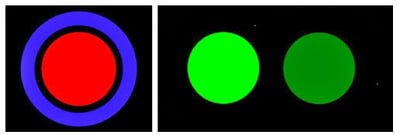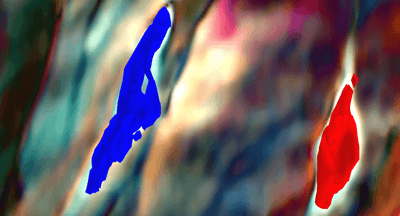In PART I of this blog entry we discussed how colour plays a vital role in seismic interpretation, particularly when attempting to simultaneously merge information from multiple attributes, but at the same time it could potentially bias our interpretation. In particular we saw how humans perceive the colour space in a non-linear fashion and we discussed the ability of our brain to infer structure from colour.
Colour can also have a significant impact on depth perception and therefore on how we perceive the position of different objects within 3D scenes. In the top left image below, the red circle appears to be at a different depth to the blue ring. This is caused by the difference in wavelength of the red and blue colours and
chromatic aberrations occurring in the eye; as a result
most people perceive the red circle as nearer but the opposite can also occur. Red-green stimuli may also cause this effect. The same effect can be perceived by looking at the geobodies on the bottom of the figure, which appear at a different distance from the observer. On the top right of the figure the brightness of the object affects our perception of its depth with the dimmer circle appearing further away, as
an effect of luminance contrast simulating the principles of atmospheric perspective in natural scenes
.
Another interesting visual effect is the one that
occurs when the chromatic appearance of an object is influenced by the visual characteristics of adjacent or intersecting objects. The two pink central squares below are exactly the same colour but appear to be of different hue due to the surrounding colours. Similarly, the grey inner squares are of the same grey shade despite the fact that they appear to be different: the darker the surround the lighter we perceive the inner square to be.
This effect can cause problems when attempting to visually compare seismic attribute responses in different parts of a large seismic section or extracted map; those responses may in fact be the same, even though they appear to be different because of the colour of the surrounding data.
The data-driven interpreter-guided paradigm GeoTeric propose is a successful way to combine the power of visual perception with the objectivity of image processing in order to get the best out of our seismic data and avoid potential interpretative mistakes.




